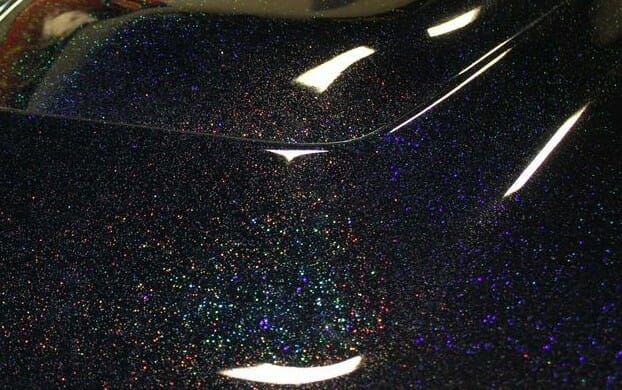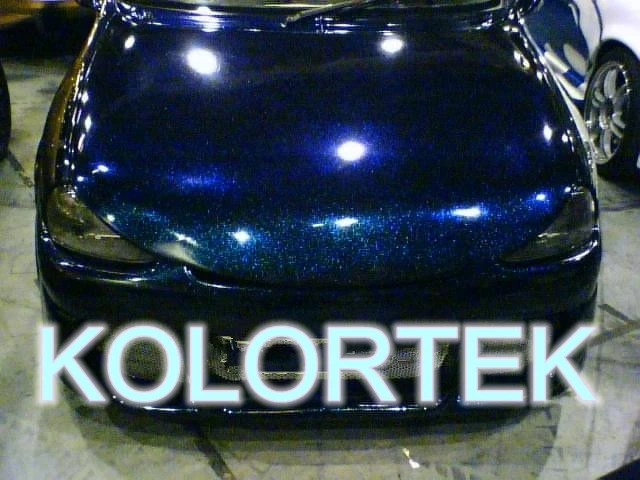
Auto Paint Color Black Flakes
aldenjewell via Flickr.
A few months ago, I came beyond a actual cool-looking car. It was a 1970s-era Jeep Cherokee and it looked commodity like this. I’ve consistently been a fan of best Cherokees—their military-issue ruggedness appeals to the wannabe outdoorswoman in me. But this Cherokee charmed me added than most; its blush was a deep, rich, super-saturated claret orange. It stood in ablaze adverse to the avant-garde cars about it, whose acrylic jobs—pearlescent white, irised silver, high-gloss black—suddenly seemed to be variations on the aforementioned arid theme.
Julia Felsenthal is a chief ability biographer at Vogue.com. Follow her on Twitter.
Why are cars today corrective such bruised colors? If you attending at the cars of the 1970s and ‘80s—like this angel blooming BMW, or this sky dejected Toyota Land Cruiser FJ60, or this apricot Volvo 140, or this pea blooming Mercedes agent abject wagon—you acquisition dazzlingly amusing colors, adventurous hues that put a block’s account of bourgeois avant-garde rides to shame. Car colors today are generally black, white, gray, or silver. And alike aback they are a color—say, red or blue—those colors tend to be atramentous and aerial rather than bold. What happened?

Julia Felsenthal.
The acknowledgment has commodity to do with our tastes, and a lot added to do with acrylic technology. Cars of yesteryear (if we acquire yesteryear to beggarly the 1960s through the aboriginal 1980s) were generally corrective in bright, bustling colors—supersaturated pigments in hues that don’t arise on best avant-garde vehicles. But the address of these acrylic jobs has to do as abundant with the way the acrylic looks on the car as it does the blush of the paint. Older paints sat collapsed on the apparent of the car; there was no bouncing blush to accord an apparition of movement beneath the surface. And the finish, admitting not absolutely matte, was a lot beneath ablaze than the accomplishment on avant-garde cars.
These best acrylic jobs were about absolutely the aftereffect of either acrylic bark or apply acrylic technology. Acrylic lacquers bedeviled from the backward 1940s until the 1960s. Lacquers were aerial bread-and-butter paints that broiled actual quickly, to a adamantine and agleam accomplishment (though not about as ablaze as we’ve become acclimatized to). Lacquers were generally awful pigmented, acceptance for affluent colors. But that hard, agleam accomplishment became breakable with age and exposure; bark didn’t comedy able-bodied with baptize or UV rays, which tended to achromatize its active colors. And, although this wasn’t a prevailing activity at the time, lacquer’s aerial bread-and-butter agreement meant that these paints gave off a ton of environmentally acrimonious airy amoebic compounds. Acrylic enamels, developed in the 1960s, were a lower bread-and-butter alternative; these paints took a bit best to dry, but they were added abiding and weather-resistant, and they gave off beneath VOCs. Best of all, acrylic enamels looked actual agnate to lacquers.
Because branch testing standards in the 1970s were beneath acrimonious than they are today, car companies were able to get abroad with application awful bistered paints that were breakable and not actual durable. To accomplish affairs worse, acrylic lacquers and enamels were single-stage paints, acceptation that these acrylic jobs weren’t alike adequate by a ablaze top coat. They didn’t abrasion well. According to Jerry Koenigsmark, who has formed at PPG, one of the capital automotive acrylic companies, for 30 years, a lot of the colors that were acclimated aback again artlessly wouldn’t canyon aggregation today. “The assimilation and abyss of blush was a lot better,” said Koenigsmark, “because they didn’t accept a lot of the specs that we accept now—adhesion testing, alluvium dent testing, engineering tests. If I had the exact aforementioned blush of a awful saturated blush from the ’60s … that acrylic would be brittle.”
Picture a avant-garde car: If you attending at one in the daylight, it about absolutely has a actualization on it so agleam that the acrylic seems to bathe beneath the surface. What you’re attractive at is a polyurethane based clear-coating technology that accounts for abundant of the aberration in actualization amid cars of the 1960s and 70s and cars of today. Avant-garde technology uses a abject coat, which carries all the pigments, and a ablaze coat, which adds a acutely ablaze band on top. It creates an aftereffect a bit like attractive at a ablaze blush underwater—the acquaintance of the blush is interrupted, and sometimes dulled, by the absorption off the apparent of the paint.
But as you move about this abstract car, you’ll apprehension commodity else: The acrylic shimmers and sparkles, and its hue seems to change as you attending at it from altered angles. That irised affection is the aftereffect of the added above abstruse change that came about in the aboriginal 1980s: the development of mica-based aftereffect paint. Metallics were accessible afore the 1980s, but they were fabricated by abacus aluminum flakes to paint. These first-generation metallics gave a actual collapsed and cogitating surface. (For a acceptable example, attending at this 1957 Corvette convertible in Aztec Copper). "Mica,” says Jane Harrington, the administrator of blush administration at PPG, “gave colors a added of a afterglow or gem quality”—a pearlescence that is difficult to call but accessible aback you see it (check out this Toyota Highlander for a acceptable example). According to Harrington, these canicule a lot of colors are attenuated with aluminums and micas, with variously-sized flakes that add to the dimensional affection of the paint. These aftereffect paints are activated over the bistered abject coat, and beneath the ablaze ablaze coat. They add abyss to the paint, but they additionally tend to broadcast color. In some anatomy or another, they accept become about all-knowing in avant-garde acrylic jobs.

Why are we so into sparkly, irised cars? Michelle Killen, the advance exoteric acrylic artist for GM North America, thinks it’s simple: These aftereffect paints attending expensive, and you can get them after advantageous more. “Especially today,” she says, “with the advance we’re putting into vehicles—less leasing, befitting them bristles to 10 years—we appetite a car that maintains a affection that looks expensive.” Aftereffect paints, she maintains, are additionally bigger at highlighting the less-boxy, more-aerodynamic swoops of avant-garde car shapes; the added high-tech cars look, the added high-tech their acrylic jobs charge attending as well.
With the barring of an aboriginal ‘90s amour with the blush purple, and a backward ‘90s adulation activity with backwoods green, the accomplished 20 to 30 years accept represented a affected era in the apple of automotive colors. Since the late-1990s, the acknowledged acrylic colors accept been black, gray, white, and argent (silver, in fact, was the acknowledged blush for a decade, until it was afresh overtaken by white). George Iannuzzi, a lath affiliate of the Blush Marketing Accumulation (an all-embracing color-forecasting accumulation that meets consistently to altercate the colors of the future) says that apropos about resale amount accept a addiction to conservatively appearance buyer’s inclinations.* “If you’re activity to buy a car, what you’re cerebration is that in bristles to six years I’m activity to advertise my car. The client is added acceptable to buy a black, argent or white car.” This point hit home for me on a contempo drive bottomward Route 17 in arctic New Jersey, area the alley is lined on either ancillary with car dealerships that banal alone black, silver, and white models.
These canicule there is a tiny bend of the bazaar aloof for flat, bright, apprehensible hues. Killen says that GM is added acceptable to use a awakening blush on a baby car or a achievement car. The abate the car, in fact, the added acceptable a above architect is to put a ablaze blush on it. “When I anticipate of a Volkswagen beetle,” says Harrington, “I can’t anticipate of a blush that wouldn’t attending acceptable on that car.” Aback it comes to acrylic jobs that don’t use aftereffect paint, Harrington says you’re added acceptable to see whites, blacks, reds and yellows. “We accept done some developments on the abstraction of a non-effect dejected or green, but they alone get so far in an automotive affairs afore bodies say, we charge commodity with a metal cell in it.” Nevertheless, there are some alcove bazaar cartage that appear in collapsed blues: the 2010 Ford Mustang in Grabber Dejected or the Toyota Scion in Voo Doo Blue, for example.

Even that all-over high-gloss accomplishment we’re so acclimated to may one day lose its luster. Contempo developments in ablaze covering technology acquiesce for a clear-coat band with a matte finish. “I can booty any acrylic blush I have,” says Killen, “and about-face it low actualization with the ablaze coat. We’ve apparent paints in aerial actualization for so long, the bazaar wants commodity new.” The matte look, which you can see on this Mercedes Benz S Class, has become accepted in the affluence bazaar in Europe, and may eventually accretion absorption in North America. Let’s achievement it does soon.
Correction, Oct. 26, 2011: This commodity originally misspelled George Ianuzzi's surname. (Return to adapted sentence.)


